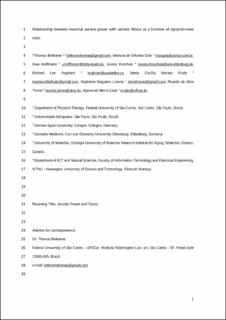| dc.contributor.author | Beltrame, Thomas | |
| dc.contributor.author | Gois, Mariana | |
| dc.contributor.author | Hoffmann, Uwe | |
| dc.contributor.author | Koschate, Jessica | |
| dc.contributor.author | Hughson, Richard | |
| dc.contributor.author | Frade, Maria | |
| dc.contributor.author | Linares, Stephanie | |
| dc.contributor.author | Torres, Ricardo Da Silva | |
| dc.contributor.author | Catai, Aparecida | |
| dc.date.accessioned | 2021-02-25T10:57:33Z | |
| dc.date.available | 2021-02-25T10:57:33Z | |
| dc.date.created | 2020-11-05T19:28:16Z | |
| dc.date.issued | 2020 | |
| dc.identifier.citation | Journal of applied physiology. 2020, 129 (3), 522-532. | en_US |
| dc.identifier.issn | 8750-7587 | |
| dc.identifier.uri | https://hdl.handle.net/11250/2730340 | |
| dc.description.abstract | Efforts to better understand cardiorespiratory health are relevant for the future development of optimized physical activity programs. We aimed to explore the impact of the signal quality on the expected associations between the ability of the aerobic system in supplying energy as fast as possible during moderate exercise transitions with its maximum capacity to supply energy during maximal exertion. It was hypothesized that a slower aerobic system response during moderate exercise transitions is associated with a lower maximal aerobic power; however, this relationship relies on the quality of the oxygen uptake data set. Forty-three apparently healthy participants performed a moderate constant work rate (CWR) followed by a pseudorandom binary sequence (PRBS) exercise protocol on a cycle ergometer. Participants also performed a maximum incremental cardiopulmonary exercise testing (CPET). The maximal aerobic power was evaluated by the peak oxygen uptake during the CPET, and the aerobic fitness was estimated from different approaches for oxygen uptake dynamics analysis during the CWR and PRBS protocols at different levels of signal-to-noise ratio. The product moment correlation coefficient was used to evaluate the correlation level between variables. Aerobic fitness was correlated with maximum aerobic power, but this correlation increased as a function of the signal-to-noise ratio. Aerobic fitness is related to maximal aerobic power; however, this association appeared to be highly dependent on the data quality and analysis for aerobic fitness evaluation. Our results show that simpler moderate exercise protocols might be as good as maximal exertion exercise protocols to obtain indexes related to cardiorespiratory health. | en_US |
| dc.language.iso | eng | en_US |
| dc.publisher | American Physiological Society | en_US |
| dc.title | Relationship between maximal aerobic power with aerobic fitness as a function of signal-to-noise ratio | en_US |
| dc.type | Peer reviewed | en_US |
| dc.type | Journal article | en_US |
| dc.description.version | acceptedVersion | en_US |
| dc.source.pagenumber | 522-532 | en_US |
| dc.source.volume | 129 | en_US |
| dc.source.journal | Journal of applied physiology | en_US |
| dc.source.issue | 3 | en_US |
| dc.identifier.doi | 10.1152/japplphysiol.00310.2020 | |
| dc.identifier.cristin | 1845429 | |
| dc.description.localcode | © American Psychological Association, 2020. This paper is not the copy of record and may not exactly replicate the authoritative document published in the APA journal. Please do not copy or cite without author's permission. The final article is available, upon publication, at: http://dx.doi.org/10.1152/japplphysiol.00310.2020 | en_US |
| cristin.ispublished | true | |
| cristin.fulltext | postprint | |
| cristin.qualitycode | 1 | |
